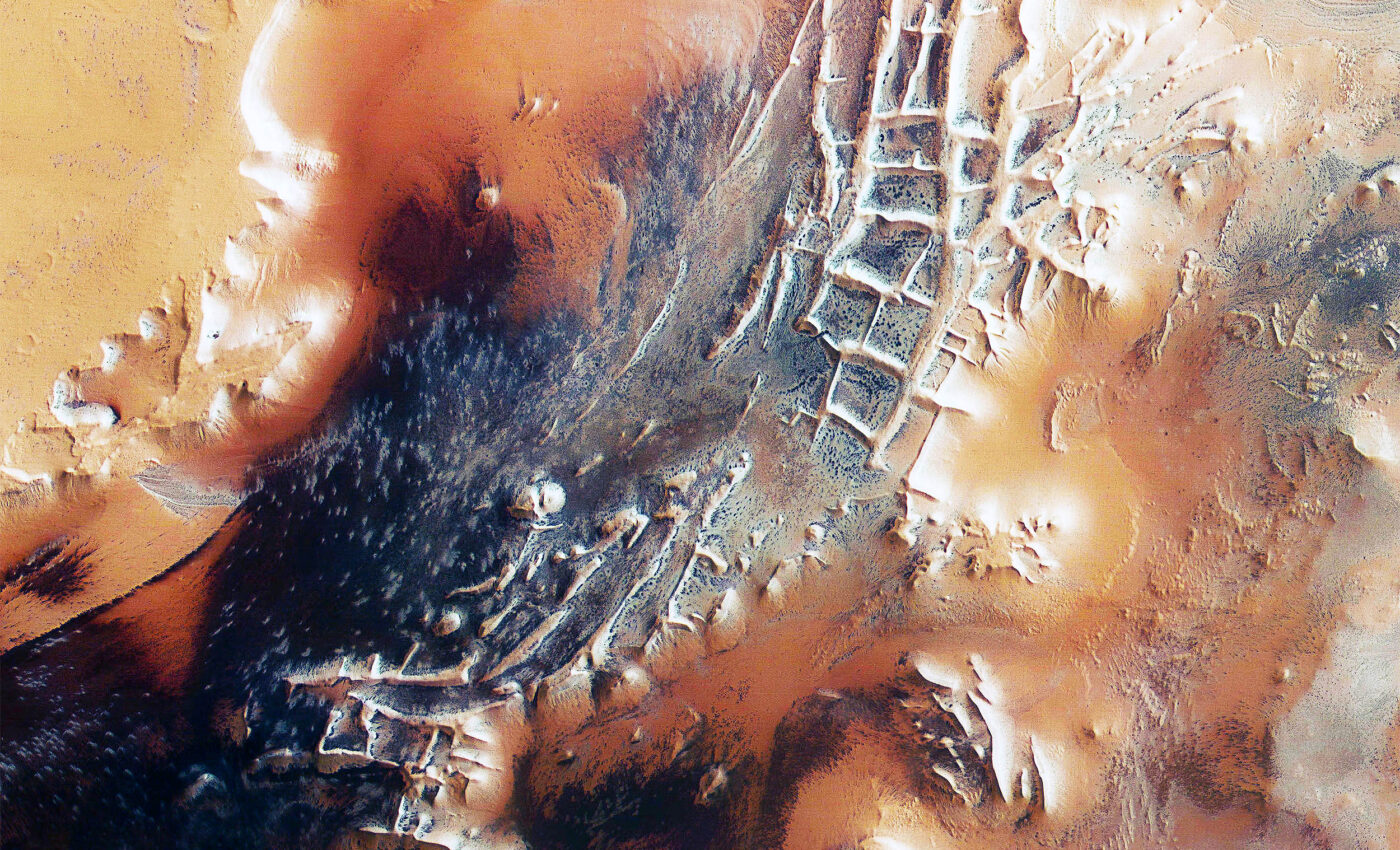
Mars Express finds "ice spiders" on the surface of Inca City
ESA’s Mars Express has captured a fascinating image of the southern polar region of Mars, revealing a landscape covered with “ice spiders” and dotted with dark spots and intricate patterns.
These features are not actual living creatures, but rather the result of a unique natural phenomenon that occurs during the Martian springtime.
These small, dark shapes form when spring sunshine falls on layers of carbon dioxide deposited over the dark winter months.
The sunlight causes carbon dioxide ice at the bottom of the layer to turn into gas, which subsequently builds up and breaks through slabs of overlying ice.
How Martian ‘ice spiders’ form on the surface
The process of the “ice spiders” formations on Mars is a fascinating one. As the carbon dioxide gas builds up beneath the ice, it eventually bursts free, dragging dark material up to the surface as it goes.
This gas, laden with dark dust, shoots up through cracks in the ice in the form of tall fountains or geysers, before falling back down and settling on the surface.
The gas bursts free in Martian springtime, dragging dark material up to the surface as it goes and shattering layers of ice up to a meter thick.
This creates dark spots of between 45 m and 1 km across. This same process creates characteristic ‘spider-shaped’ patterns etched beneath the ice, giving rise to the spooky story that Mars “ice spiders” may be lurking below.
Insights from ExoMars Trace Gas Orbiter
In addition to the Mars Express imagery, another ESA Mars explorer, the ExoMars Trace Gas Orbiter (TGO), also captured images of the Mars “ice spiders” patterns.
The TGO images reveal the tendril-like patterns especially clearly, lying near but outside the region shown in the new Mars Express image.
The Mars Express view shows the dark spots on the surface formed by escaping gas and material, while the TGO perspective also captures the spidery, web-like channels that are carved into the ice below.
Angustus Labyrinthus — also known as Inca City
The dark spots captured by Mars Express can be seen all over the image, creeping across towering hills and expansive plateaus. However, most can be seen as small spots in the dark region to the left, which sits just at the outskirts of a part of Mars nicknamed Inca City.
The reason for this name is no mystery, with the linear, almost geometric network of ridges being reminiscent of Inca ruins. More formally known as Angustus Labyrinthus, Inca City was discovered in 1972 by NASA’s Mariner 9 probe.
Scientists still aren’t sure exactly how Inca City formed. They surmise that sand dunes could have turned to stone over time.
Perhaps material such as magma or sand is seeping through fractured sheets of Martian rock. Or, the ridges could be ‘eskers‘, which are winding structures related to glaciers.”
Landscape shaped by time and nature
The landscape of the southern polar region of Mars is one that has been shaped by time and the forces of nature.
Towards the middle section of the image, the landscape changes somewhat, with large roundish and oval swirls creating an effect reminiscent of marble. This effect is thought to occur when layered deposits are worn away over time.
To the right-center of the frame lie a few prominent steep-flanked, flat-topped mounds and hills that rise up for more than 1500 m above the surrounding terrain.
These form as softer material is eroded over time by flows of wind, water or ice, leaving behind the harder material that forms these hills.
The ground towards the right (north) becomes increasingly covered in smooth, light-colored dust. Some signs of the Mars “ice spiders” can be seen scattered across the plateaus here, lurking amongst various canyons and troughs.
Ice spiders, Inca City, and the never-ending wonders of Mars
As ESA’s Mars Express and ExoMars Trace Gas Orbiter continue to explore the intriguing landscape of Mars, they reveal the Red Planet’s dynamic and complex nature.
The discovery of the mysterious Mars “ice spiders” in the southern polar region, the enigmatic Inca City, and the evolving terrain shaped by erosion and time demonstrate the importance of ongoing Mars exploration.
These findings captivate our imagination and provide valuable insights into the geological processes and history of our neighboring planet. With each new observation, we take a step closer to unraveling the secrets of Mars and understanding its place in the cosmic puzzle.
The full study was published in the Journal of Planetary Science.
—–
Like what you read? Subscribe to our newsletter for engaging articles, exclusive content, and the latest updates.
Check us out on EarthSnap, a free app brought to you by Eric Ralls and Earth.com.
—–













